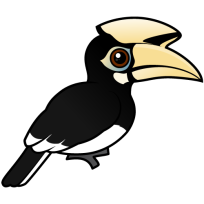Also known as: Philippine Hornbill, Kalaw, Great Philippine Hornbill
The Rufous Hornbill is a large type of hornbill endemic to the Philippines. It is found in forest habitat across 11 Philippine islands.
There are three subspecies of Rufous Hornbill. The Northern race, like our Birdorable version, can be recognized by its large all-red bill and red or pale blue eyes. Southern birds, in two different subspecies, all have blue eyes and the lower part of the massive bill is yellow rather than all red. Rufous Hornbills have white tails that often appear pale tan from staining.
Rufous Hornbills feed on seeds, fruit, and insects. Fruit are the preferred food. The species is vulnerable to extinction due to habitat loss and illegal hunting. This is a little-studied bird with few details about breeding and behaviors known to science.
Added to Birdorable
Hatched December 19, 2020
Measurements
Length:
2 to 2.1 feet
(59.9 to 65 cm)


































